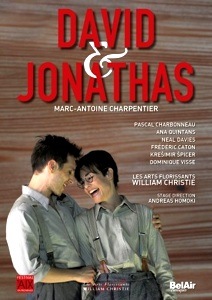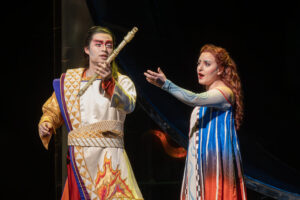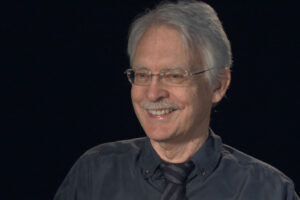
Marc-Antoine Charpentier’s opera David et Jonathas, written for a celebration at a Jesuit school in 1688, premiered together with a Latin verse drama, Saul, now lost. As was the custom, acts of the opera alternated with acts of the drama, which had its own music. For their subject, Charpentier and his librettist Père François Brétonneau chose the episodes in David’s life just before he became King of Israel.
As the opera opens, Saul learns from the Witch of Endor (here, as in Chaucer, a Pythoness) that he will lose his children and crown for his failure to obey the Lord. Saul believes his commander David will bring this about and banishes him. David finds refuge with the Philistines and leads them to victory in battle. As David is gaining power with the Philistines, Saul declares a truce with them so he can watch over his enemy. David returns and has a tender reunion with Saul’s son Jonathan. They love each other deeply.
David’s rivals convince Saul that David is plotting treason. David is exiled again; Saul ends the truce and a battle is imminent. Jonathan has a furtive visit with David. David vows to keep Jonathan safe. Saul attacks the Philistines and his son is wounded. Jonathan dies in David’s arms and Saul falls on his own sword. David is hailed as the new king, but he forgoes the celebrations choosing instead to mourn.
This was an extremely unconventional operatic subject for the time; however it was one uniquely suited to their Jesuit audience. Love is at the core of Jesuit spirituality; Jesuit scholars write of their “continuous search for how best to love as an authentic human being before a loving God” and describe finding God as “falling in love in a quite absolute, final way.” Thus, this opera’s depiction of a love so all-consuming, selfless, and spiritual, could be said to provide a model for the love that Jesuits aspire to feel towards God and towards each other.
The opera further sets up David, who was believed to be a direct ancestor of Jesus, as a kind of proto-Jesuit by giving him two extraordinary monologues where he addresses the Lord directly. In the first, he vows to choose peace over retribution and in the second he declares that he values his faith above all else, even Jonathan’s love. The opera clearly contrasts David’s faith and love with baser intrigues around him, pointedly and repeatedly reminding its audience that pursuit of worldly power or giving in to anger at time of crisis are poor choices compared to following the Jesuit teachings.
Not surprisingly, it was a hit in the Jesuit community. The work was revived successfully at other Jesuit institutions over the next 50-odd years before lapsing into obscurity. Now, three centuries after the work premiered, that combination of context and circumstance that caused the work to resonate so deeply with those audiences is lost. A contemporary audience will view this work as a homoerotic love story, particularly since the libretto reads like biblical slashfic.
For his production, filmed at the Festival d’Aix en Provence in July 2012 , director Andreas Homoki goes so far as to recast the work as a gay star-crossed lovers saga, stripped of biblical and Christian connotations. The Bible mentions that David and Jonathan kiss and that kiss is shown here even though the libretto does not specifically reference them kissing. It doesn’t feel imposed on the work at all. The staging, like the Bible, is silent on whether the physical nature of their relationship goes beyond kissing; the audience can decide.
Set somewhere in the Middle East at an unspecified point in recent history, a flashback during the overture reveals David and Jonathan as childhood best friends even though they come from opposite sides of the haberdashery counter. David comes from team Fez and Jonathan team Fedora. Saul disapproves of their fraternization, but his wife, a mute character not in the libretto, convinces the reluctant Saul to continue to let them play together.
In further flashbacks scattered through the show, we learn that Jonathan’s mother was playing hide and seek with the children when she suddenly collapsed and died. Saul is unhinged by his grief and blames David for her death. The crucial scene with the witch of Endor, moved from opening the show, to after Act III, now depicts Saul’s hallucinatory torment by the spirit of his ex-wife and the ghost of his predecessor King Samuel. This stokes his jealous rage and directly precipitates the tragic dénouement.
A footnote in the DVD tersely explains the movement of the prologue, “Through common agreement, the artists working on the production decided to insert [this scene] between acts III and IV to ensure the clarity and coherence in the storyline.” It does help tell the reconceived story, but it seriously compromises one of the work’s most striking innovations. The dark brooding prologue is, to my knowledge, unprecedented for a French Baroque opera.
Transitioning from the bubbly overture to the brooding, dusky music for the witch of Endor scene is a bold, dramatic choice that creates a very high degree of dramatic tension from the outset. This is all lost as the reordered work follows the more conventional pattern of overture followed by festive choral scene. Admittedly, an audience that didn’t know their scripture or hadn’t bothered to read the first lines of the plot summary might be confused, but that’s a problem that a staging should easily solve without dumbing down the piece.
This production further undermines the musical arc of the show through the insertion of the flashbacks and other changes of scenic configuration not required by the libretto. These happen during orchestral music so the musical flow is not interrupted, but it still suffers because the curtain keeps going up and down when it shouldn’t. Even the briefest orchestral sequence becomes an excuse to ring down the curtain and reconfigure the playing area. This chops the opera’s paragraphs up into individual sentences, undermining the way the audience perceives the structure of the piece and interfering with the way the composer builds to a climax in a scene.
These interpolations come across as fussy, unnecessary distractions from a moving performance by a very well directed cast and chorus – each character vividly realized and the many subtleties of the relationships between the characters drawn out. The probing television cameras caught no moments, as they typically do, of singers working overly hard to act. The few scenes between David and Jonathan capture both their devotion to each other and their deep anguish at the tribulations that they face.
As might be expected from a William Christie-led performance featuring his own Les Arts Florissants, the musical performance is exemplary. The orchestral playing is flexible, colorful, and expressive without any pedantry or fussiness. The singing by the entire cast and chorus displays similar virtues: clear, effortless declamation of the French text married to vocal performances of considerable vocal and emotional that never resort to bluster or bathos.
Pascal Charbonneau, the David, has a high tenor voice with a surprising amount of power as well as the necessary tenderness and delicacy. His Jonathas, Ana Quintans, faces the difficult task of playing a role conceived for a boy soprano. She conveys her character’s youth and ardor without ever sounding matronly, or, even worse like an ersatz boy soprano Dominique Visse makes an imposing impression at the Pythoness–using the steely edge in his voice to achieve an intimidating imperiousness. He never lets the performance turn into camp despite the easy temptation of being costumed in a “Lucy Ricardo” housedress.
As the scheming Philistine general Joabel, Kresimir Spicer has to overcome both a cartoonish getup and unfortunate stage business where he makes a rejected pass at David. He sings elegantly and gives a complex performance at the bad guy of the piece. Only Neal Davies as Saul disappoints, his voice seeming pressured and overly forced; the acting is forced as well. He starts out overly manic and gives himself no where to go at the big moments. run out of rope at the big moments.
The utilitarian costumes are by Gideon Davy. They unconvincingly mix Middle Eastern and Arabic elements and end up confusing the relationships and affiliations between characters. The sets, or scenography as the program notes would have it are by Paul Zoller. He created a seemingly simple wooden box that is capable of many magical reconfigurations. If only the director, hadn’t played with this toy quite so much!
All in all, an imposing performance of an imposing work. If you get this DVD–and you should–do try to watch the show at least once in the order specified by the score, so that you hear the score as intended.


























Comments